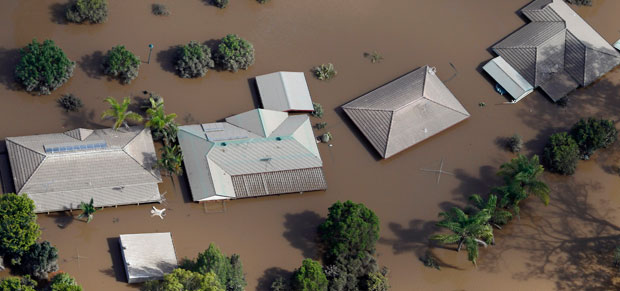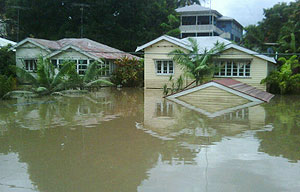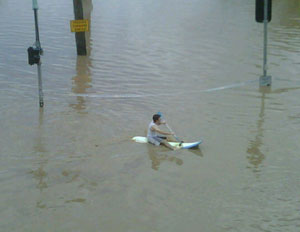Australia counts the cost of Queensland floods
Brisbane and other devastated areas of Queensland face rebuilding on a scale of “post-war proportions” after flood levels in the city peak. Jonathan Miller reports from Australia.
Major flooding across Queensland has caused damage which could take years to rebuild, officials warned.
Flood waters in Brisbane, Australia’s third largest city, peaked on Thursday (local time), but the disaster is far from over, as a clean up operation of “post-war proportions” begins, according to the state’s Premier, Anna Bligh.
The capital of Queensland state resembled a muddy lake with debris from houses and businesses washed away down the Brisbane River. Rising water has flooded 12,000 homes in the city of two million and left 118,000 buildings without power – and other areas of Queensland are just as badly affected, or worse.
‘War zone’
Queensland Premier Anna Bligh said Brisbane looked “more like a war zone in some places”.
“All I could see was their rooftops,” Ms Bligh said of the city, after surveying the disaster from the air.
“Underneath every single one of those rooftops is a horror story.”

As 35 suburbs were flooded, some residents were forced to use boats to move about inundated streets, where traffic signs peeped above the stagnant water.
Ms Bligh added: “This morning as I look across not only the capital city, but three-quarters of my state, we are facing a reconstruction effort of post-war proportions.”
Jordan Rice: you will remember his name
Jordan Rice was 13 years old from Toowoomba, Australia. Jordan Rice sacrificed his life for his little brother during the devastating floods of Queensland in January 2011. Jordan Rice is a hero and now you will remember his name.
Read more from the moving account of Channel 4 News Young Blogger, Louise Jones, on the heroism of Jordan Rice in the Queensland floods
An emotional Ms Bligh said her state, reliant on farming and mining in rugged outback regions, would recover regardless of the cost and estimates that three quarters – an area the size of South Africa – was now officially a disaster zone.
The floods have killed at least 19 people and 61 are missing, according to revised figures. Toowoomba and the Lockyer Valley region, west of Brisbane, have been completely devastated, with whole towns unrecognisable.

Risk of more flooding
Officials warned of the real risk of further severe flooding in the coming weeks, with two months of the wet season ahead and already overflowing dams requiring seven days to empty to normal levels to cope with more heavy rains.
The Bureau of Meteorology said a monsoonal storm in the Coral Sea off Queensland’s north coast was expected to form into a cyclone in 24 to 48 hours, but while it would bring fresh rains to Queensland it was expected to move away from the coast.
Read more from Channel 4 News on the Australia floods: what causes such severe weather?
Queensland has received so much rain in the past two months the ground is fully waterlogged and dams are full, meaning any more heavy rain will simply exacerbate already flooded rivers.
Some analysts have predicted the flood will cost the economy £6bn, with mining and agriculture the worst industries affected. The floods are predicted to cost insurers nearly $1bn.

Rebuilding to take years
Brisbane Mayor Campbell Newman on Thursday issued a rallying call for volunteers to start cleaning up his flooded city.
“Brisbane people today I am calling on you to really help your community. Tomorrow if the water goes down sufficiently, I want clean up crews out there across the city,” he said.
“Anyone with a bulldozer, front-end loader or dump truck, we want to hear from you. We will send you in when the water goes down to clear local streets,” he said.
Newman warned residents that when floodwaters recede the threat of disease would remain as raw sewage has contaminated many flooded homes.
“I think the clean up will take many, many weeks and the reconstruction will take one and a half to two years,” he said.
'A long slow road to recovery'
Before Tuesday, we'd never spoken to any of our neighbours, writes Kate Stewart, a resident of Brisbane, for Channel 4 News.
But in the midst of disaster, everyone is keen to swap stories, share information and offer assistance. In a matter or hours, we had gone from barely seeing our neighbours to being on first name basis with most of them. We briefly swap greetings and news. Despite living right by the river, we have been extremely lucky so far. It looked like that luck was going to hold.
Yesterday, one of the old-timers from the apartment block next door had pointed out the height of the 1974 flood – a height that would have had the water lapping at our doors. Luckily, despite the predictions, the river didn't quite reach the 1974 levels and we were quite safe. The guy from the downstairs flat has an engineering background and wasn't sure if our cracked retaining wall was going to hold if the river got much higher. We were relieved to see that was no longer a worry.
A few days ago, the current situation couldn’t have been imagined. Now all sorts of extraordinary sights are commonplace – whole suburbs underwater, supermarkets emptied of basic necessities, people escaping roof-high water levels with just the clothes on their backs.
The waters are receding now, but some of the toughest challenges are to come. With most of the state under water and the floods moving to NSW and Victoria, food shortages, power outages due to lack of coal, failing sewerage systems and overwhelmed water treatment plants are all becoming a reality. It's going to be a long slow road to recovery.
-
Latest news
-
Police try to shut down right-wing event as Nigel Farage speaks3m

-
‘Many things Netanyahu has done I disagree with, but I’m not giving up on Israel’, says top-ranking Democrat4m

-
Could US House be about to vote on Israel, Ukraine aid bill?2m

-
Number of people out of work due to long-term sickness at record high3m

-
Creating deepfake porn to be made a criminal offence after C4 investigation6m

-




